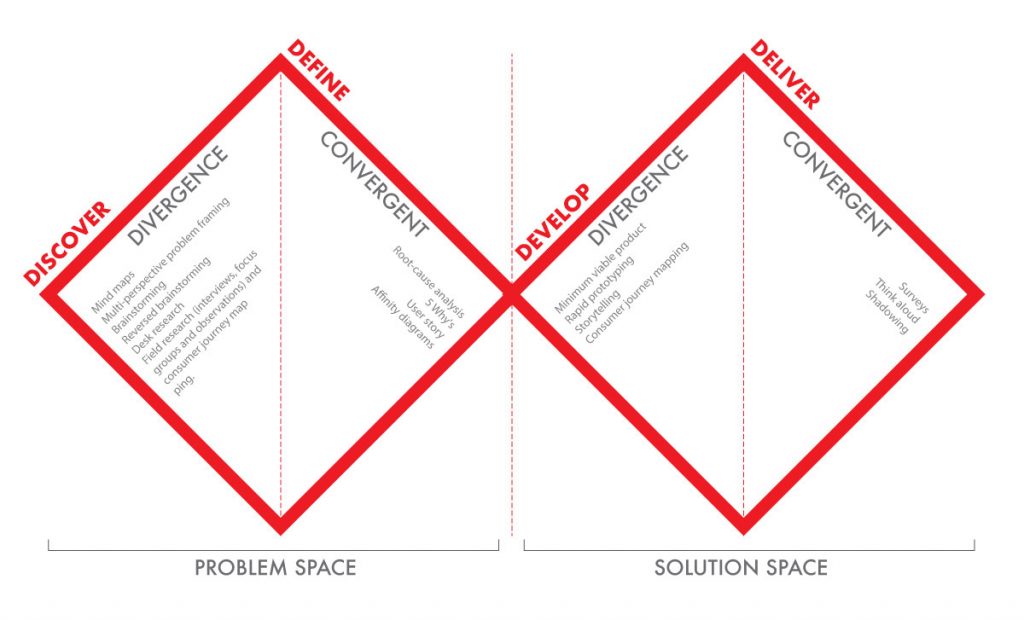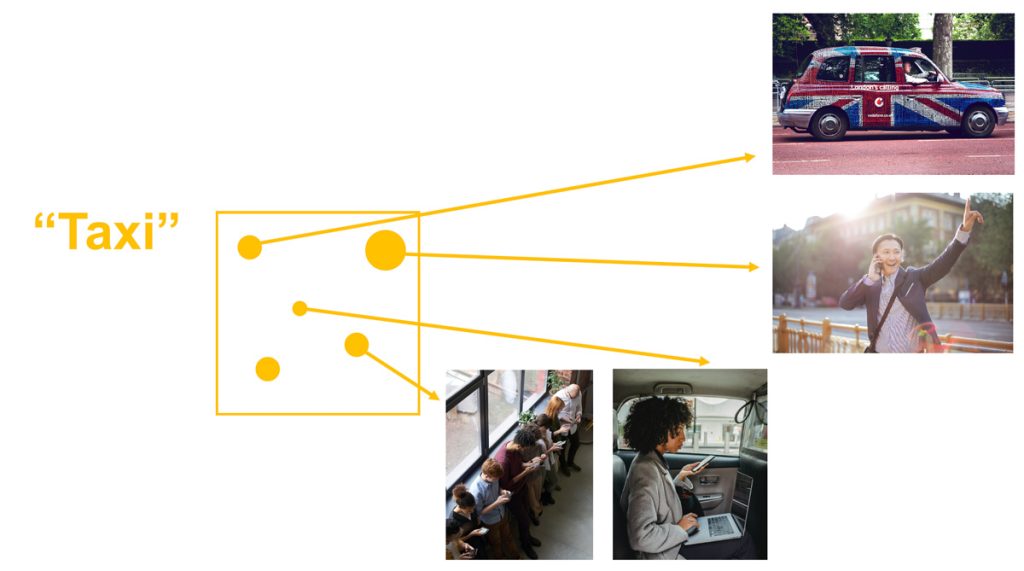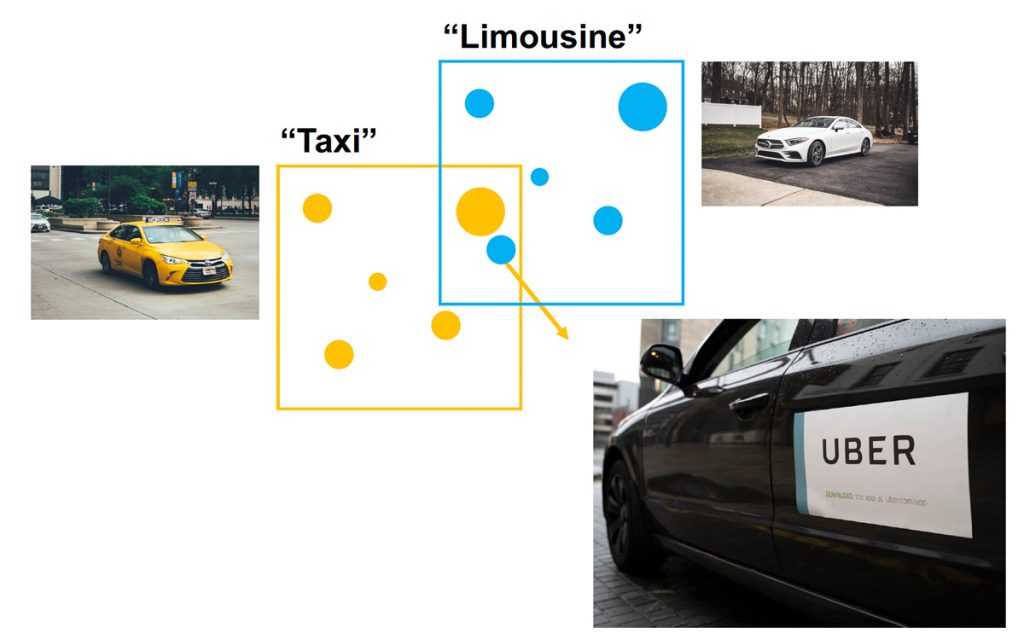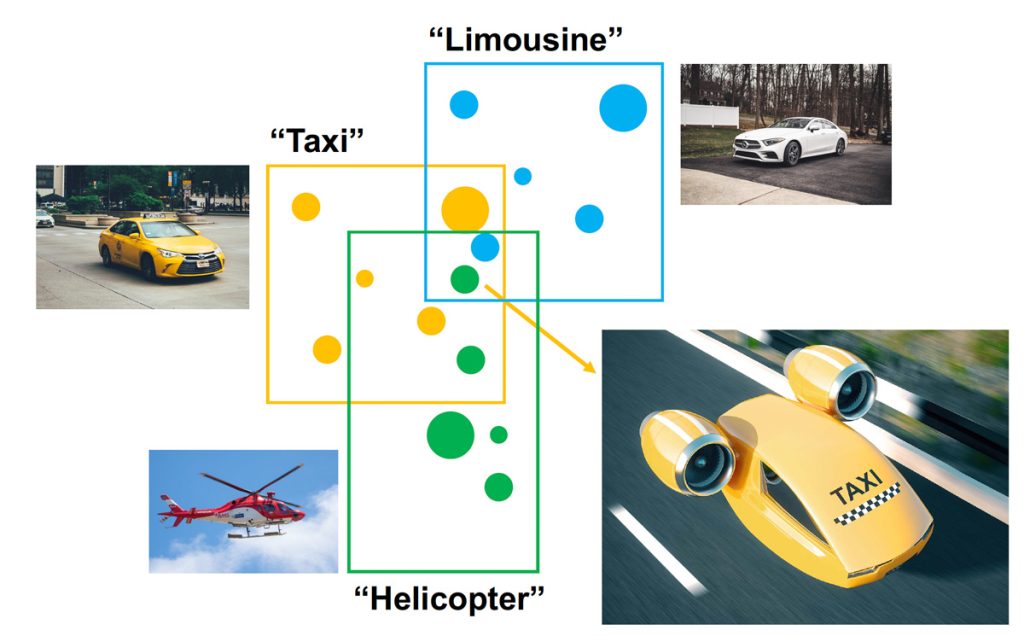Using the MPPF Method in the Double Diamond Design Process
We explored the design thinking process and introduced various models, including the Double Diamond Design process, which reflected several characteristics of design thinking, although it still shows some linearity in its flow through the four stages: Discover, Define, Develop, and Deliver. As you may notice when looking at the Double Diamond model, the centricity around the problem definition is located at the exact intersection point before the problem space, and the solution space reflects design thinking theories that I shared previously in the updated Design Thining Books list, especially Kees Dorst book, Frame innovation.
The MPPF Method in the Double Diamond Design Thinking
As designers, several designers focus on the research and prototype part of the process but focus less on the definition of the problem itself, which is where innovation lies; we need to find the right problem to solve and create the right solution. What makes problem framing more challenging is the dynamic nature of problem framing, as problem definition keeps changing as we build more and more understanding of it, as highlighted by Richard Buchanan in his Wicked Problems paper.

Therefore, one helpful method for framing problems is Multi-Perspective Problem Framing (MPPF), developed by Dr Stuart English, a former Associate Professor of Design and the CEO of Ideas Lab Design Consultancy. This method helps companies define their problems not only to find the right solutions but also to define their intellectual property and patent characteristics.
The Interview with Dr Stuart English
This article introduces the MPPF method through a video interview with Dr English, describing it and explaining how to use it to explore and define problems and solutions. After the interview, you will find the PDF whitepaper that describes the method in more detail.
Transcript
Rafiq Elmansy 00:07:
Hello, everyone. My name is Dr. Rafiq Elmansy. Today, we have Dr. Stuart English, who introduced us to his multi-perspective problem framing method, a profound way to solve Design Thinking problems. Welcome, Dr. Stuart.
Stuart English 00:25:
Thanks very much, Rafiq. I’ll just share my screen. I’m Stuart English, and I’m CEO at Iconet ideas lab. And I’d like to introduce an innovation method that we’ve termed multiple perspective problem framing.
Stuart English 00:47:
Now, multiple-perspective problem framing is based on the idea that our capacity to innovate is bounded by the way we’re able to perceive problems and opportunities. In design terms, this is often called a well. This is often an understanding of problem space and how we understand the factors that relate to the problem. But in multiple-perspective problem framing, we call this a value arena because it is continually developing, it’s complex, it’s fluid, and it’s ill-defined, and it doesn’t necessarily relate to a problem; it may just relate to a situation.
So, in design thinking, we need to know about a lot of different things. Design thinking is often described on particularly innovation in terms of design thinking is often described as an overlap between business viability, human desirability, and technical feasibility, which means we need to know about people we need to know about, we need to empathise with people’s experience, we also need to understand how things can be made practically.
And we need to be able to prototype those things. And we also need to understand how they sit in the world. So, how do our propositions sit in relation to lots of other factors, from legal factors to environmental factors to social factors? So, we need to gather a vast amount of information to build up that value arena.
In terms of the Double Diamond, the Design Council Double Diamond, multiple perspective problem framing, sits at the end of the Discover phase, through the Define Phase and into the start of the Develop phase. So, it is about expanding the investigation that we make into the factors that are relevant to our discovery. When we have that kind of complex information, we need to adopt certain tools to be able to define what’s important and to be able to frame the problem effectively.
And we need to be able to use that as the basis for ideation. So, multiple prospective problems, framing fits at the end of the Discover phase and at the beginning of the end of the Discover phase, through the design phase and into the start of the developing phase. And it involves collecting data from wildly different perspectives. Synthesising this into one complex dynamic map of interrelated factors. We call this a value arena.
This has been combined with novel methods of interpreting complexity, for example, relational grouping and centrifuge methods, to arrive at a set of cornerstones of innovation. These are the critical framing factors that allow us to focus our attention on the space that’s important to us. So, critical framing factors create the space in which innovative strategies can be fully conceptualised. These cornerstones of innovation also underpin the articulation of universal form that describes the genre of particular design things.
So, we can think of design as a universal design, which is a grouping of things. And we can think about design in terms of particular physical or particular physical things. And here we’re talking about universal form. We’re talking about the genre of design things.
Stuart English 05:10:
So, in summary, multiple perspective problem framing can be described as a 12-stage model. And that 12-stage model can be split into three sections. First of all, in the knowledge section, what do we know? Secondly, the skills section includes using and refining design thinking and framing skills. And thirdly, the expertise search section is about applying discipline-specific expertise and resources. In the first stage, we’re concerned with identifying fields of inquiry. So, you know, what are those investigations that we need to make in order to collect that data from the perspective of business viability, human desirability, and technical feasibility? So, what fields of inquiry do we need to investigate? Then, within each of those fields of inquiry, we can create push questions. Now, the thing about push questions is they are simply about gathering information.
They’re about completely populating those fields of inquiry; as much as possible; we may collect data that we don’t subsequently need. But we don’t really know that until we get to that point. So, in answering those push questions, we collect push data, which allows us to map out the value arena. So it is a value ring, then is a complex map of interrelated factors that completely describe the situation that our proposition will be going into. The second phase is really about giving form to that to that value arena. So, the first thing we can do here is look at conceptual grouping; we may have similar factors or related factors that have appeared in different fields of inquiry.
And these can be grouped together. To create one conceptual grouping or a number of perhaps conceptual groupings. Another thing we can do is use the centrifuge method, which is about making personal and expertise-based judgments to interpret the value arena. This can be done individually, or it can be done with with with a team; an executive team could bring different perspectives to that central use method. But essentially, this is about deciding on and agreeing on what key framing factors are and perhaps more peripheral or contextual factors. So, we retain all of the data that we’ve created within that value arena.
But we give it some form; we use the centuries method to identify what we term cornerstones of innovation, which are these keyframing factors that focus our design, innovation, and attention. And those cornerstones of innovation can be used to create a universal form. So the universal form is the genre of the idea, not the genre of the idea into which or, or in which a variety of particular designs might occur. We can then move on to the third stage, which is really about the focusing of expertise. And what we want to do with all of the data that we’ve collected. So, it starts with the definition of pull questions.
Pull questions are different from push questions in that pull questions are about how we can do something and how we can solve this problem. How can we provide this benefit to the customer? Push questions, or as an example, push questions, might ask how much water goes down this river in a minute. A pool question might be, how can we get across this river? So, poor questions are about solving some sort of problem or addressing some kind of issue. And in response to those poor questions, we can generate a whole variety of ideas and solutions. And this is really at the start of the development phase of the double diamond. In doing this, we can create purposeful ways of seeing or a mental model of the situation. So we can decide how to see the situation in order to elicit the response that we tried to create. You know, this is very prominent in advertising, where we’re presented with a way of seeing a particular situation or particular product in order to encourage us to buy the product.
So, that mental model is a choice. Really, it isn’t the way the situation is; it’s a way of representing that situation in order to encourage us to do something. Finally, we can use the entirety of the value arena map to defend our purposeful proposition. We already have all of the related data that we’ve created through that value arena. And we can use it to defend the proposition or the mental model that we’ve proposed. Because all of that relates to all of that data, it remains related within that map. And so not only can we present that purposeful proposition, but we can also defend it. So, this is really a summary of the 12 stages of multiple perspective problem framing. I’d be delighted to hear from anyone who is interested in this or interested in applying this, so yeah, please, please do to do make contact me if you’d like to do that. Thank you very much.
Rafiq Elmansy 11:54:
Thank you so much. The pursuer This is very interesting. I hope you all enjoy the multi-perspective problem framing method and try to explore to think how this method can be useful in your design thinking practice. Feel free to share your thoughts with us. Thank you so much. Thank you
Download the MPPF Method Whitepaper
In addition to the video description above, the PDF whitepaper below describes the MPPF method in more detail, including its structure and flow. For more information about the method, visit the Ideas Lab design consultancy website.

Multi-Perspective Problem Framing
by Dr Stuart English
The Problem Space in the Double Diamond Design Process
To implement the MPPF method effectively, we need to understand the concept of universal forms and how they contribute to understanding the design problem, as Dr Stuart described in his lectures. As we explore problems through different research methods in the Discover stage, we try to identify the characters of problems. However, our understanding of the problem is usually restricted by our mental models and how we perceive the elements of the problem.
The universal form defines the different elements as conceptual models represented by a frame containing all the possible connected points to the element. To illustrate this concept, think of the word “Taxi” and what it means. We can think of it as the hired yellow car in our cities. But, we can extend our thoughts to related concepts (dots in the figure) such as:
- Waiting for the car to come
- Setting for a long time
- Working in the car
- No vehicles late at night

When we think of the taxi as a concept, we extend our mental model and the different aspect concepts that are related to the word “taxi”. However, the universal idea of the taxi is separate from other concepts. And this is why the opportunity emerges. For example, let’s connect the word “taxi” to the word “limousine.” The university of the word limousine can represent luxury, on-demand, and ample interior space. If we mix the two universals, we can come up with a concept such as Uber or Uber Lux.

Let’s extend the example to even more concepts and consider the concept of a helicopter. Its universal concept can reflect flying fast and avoiding busy roads. If we merge the three concepts, we can reach innovative concepts such as a flying taxi service that provides a fast, luxurious commuting experience.

Conclusion
The definition of problems and how they contribute to forming solutions presents the central point of the Double Diamond Design Process. However, identifying the problem and the different opportunities that can merge out of it. Multi-Perspective Problem Framing is a useful method for framing problems and exploring the opportunities that can emerge from them. Through the interview with Dr Stuart English, we explored how to use the MPPF tool to frame problems as we move from the problem space to the solution space in the Double Diamond design process.
Bilbiography
Buchanan, R., 1992. Wicked problems in design thinking. Design issues, 8(2), pp.5-21.
English, S., 2011. Multiple perspective problem framing. How do designers think about situations to reveal hidden opportunities. PhD published, Northumbria University, UK.
Dorst, K. 2011. The core of ‘design thinking’ and its application. Design studies. 32(6), pp.521–532.
Dorst, K., 2015. Frame innovation: Create new thinking by design. MIT press.
Moor, T. and English, S., 2011. Reflections on multiple perspective problem framing.






